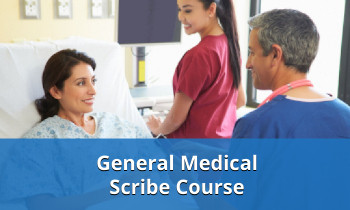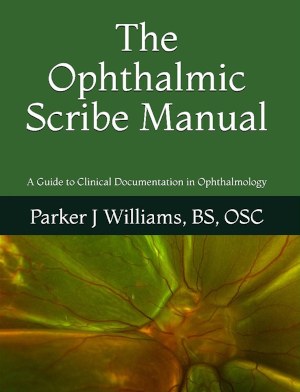
Medical Scribe Training
Learn skills needed to become a scribe with these training options.
As medical scribes become more popular with doctors and hospitals the need for training is increasing as well. Medical scribe training can take many forms including online courses, books and manuals, specialized training by large companies and courses at local colleges. There are several key questions related to medical scribe training:
- What is a medical scribe?
- Which topics are taught during training?
- What are the different training courses?
Online Courses
Several online courses are available and are taught by current and former scribes, physicians and other healthcare providers. The medical scribe training courses offered through Medical Scribe Training Institute include a general medical scribe training course and several specialty training courses like Emergency Medicine, Family Medicine and Urgent Care. Upon completion of each course students will become a certified medical scribe and receive a certificate of completion.
What is a Medical Scribe?
The medical scribe is a medical paraprofessional responsible for facilitating documentation related to doctor-patient interactions. The scribe has many other duties as well which include – but are not limited to – recording, entering and maintaining information in EHR or electronic health records. A medical scribe will also collect and organize data, take dictation, schedule appointments and perform other clerical tasks.
To be effective, a medical scribe needs intensive training – which may occur online, in a classroom, on-the-job or in a combination of these formats. Continuing education is also important to keep skills current in an ever-advancing field. Medical scribes are becoming a fixture in more and more care environments: This is particularly true in emergency medicine. The field is growing quickly as physicians grapple with the increasing demands of electronic health records (EHR).
Medical Scribe Training Topics
There are a few pre-requisites to becoming a medical scribe. First, a medical scribe must be high school graduate. For some employers, it is preferable for a medical scribe to have a work background, some college courses or a degree in science: particularly in biology or pre-medicine. This will give the new scribe a leg up as they train for a new career as they will be more familiar with much of the terminology. Since many medical scribes go on to become physicians themselves, the training and clinical experience as a medical scribe can prove invaluable. A medical scribe will have a variety of roles and responsibilities and, so, will need to receive focused training in a variety of job-related topics. Some topics that Medical scribes may see in training include:
- General medical knowledge
- Anatomy and physiology
- Bloodborne pathogens
- Radiology, EKG, MRI and other results
- Pharmacology
- Discharge procedures
- Coding
- Medical billing
- Workflow management
- Medicolegal and patient privacy issues including HIPAA
- Medical and legal documentation
Medical Scribe Training Books & Manuals
There are several books that may be used in training new medical scribes. These well-known resources are not just for novice scribes, but often also serve as a reference for experienced scribes. These can also be used by physicians in the field as a guide for their own scribe programs.
The Ophthalmic Scribe Manual
The Ophthalmic Scribe Manual: A Guide to Clinical Documentation in Ophthalmology is a comprehensive manual for those serving a particular medical specialty.
After three years and 20,000 patient encounters this manual was written by a medical scribe with deep expertise in ophthalmology. The book is focused on ophthalmology, but many chapters are applicable to medical scribing in other areas of medicine.
Independent Schools and Colleges
Saginaw Valley State University
The Center of Academic Innovation at Saginaw Valley State University has partnered with Covenant HealthCare to train and provide clinical experiences to medical scribes. They call these scribes “physician facilitators” and train the undergraduates to provide and maintain electronic medical records, or EMR, for doctors.
Students learn all the pertinent academics – including medical terminology, procedures, understanding of healthcare delivery and record creation – as well as gain clinical experiences working with real physicians treating real patients. Since many medical scribes are in pre-med programs, the program is beneficial. It builds both real-world experience and professional relationships with physicians, both of which can be very important in the future. Graduates may be offered a paid medical scribe job through Covenant Healthcare upon graduation, but opportunities are competitive.
Scribe Academy at Grand Valley State University
Grand Valley State University is home to Scribe Academy, which trains its students to work with healthcare professionals in local emergency medicine programs. Students in Scribe Academy learn in a variety of educational settings. Classes are offered online and in the classroom, and students also participate in clinical experiences. Class time consists of 65 hours of instruction, while clinical instruction is 40 mentored hours.

Many students enrolled in the school are seeking degrees in medicine and science at GVSU or other universities. Some are looking to add clinical experience to a resume, while others are looking for paid work experience in the medical field. Successful completion of the medical scribe program can lead to employment with Helix Scribe Solutions.
Company Led Healthcare Scribe Training Programs
Several medical scribe companies offer their own specialized training programs. This training occurs after an applicant is hired. The training can be intense and successful completion is a requirement for continued employment. Usually company sponsored training involves online, classroom and on-site components. This training is very thorough and prepares a scribe to become productive once they are permanently placed at a particular location. Trainees are paid during this time, in some instances at a lower hourly rate, which is increased once training is completed.
ScribeAmerica Training Program
Scribe America – a leading medical scribe company – offers its own training program. The demanding 120-hour program is broken up into a 3-step process geared toward graduating the best emergency medical scribes in the field.
Three steps to ScribeAmerica training
- Classroom training
First, scribes spend 2 weeks in the classroom. This is considered the orientation period in which trainees will be introduced to the skills – including medical terminology, HIPAA compliance, system software, documentation, billing and coding – needed to be a successful medical scribe. Next, working under an experienced scribe, the scribe in training will begin Step 2.
- Supervisory period
The second step is a supervisory period in which the prospective scribes gain clinical experience working shifts with their training partners. The experienced scribe provides overview and feedback as the new scribe puts his or her skills to work. This one-on-one training is highly intensive and includes a final assessment of clinical performance.
- Re-assessment and review
Step 3 is ongoing re-assessment, review and continuing education to ensure scribes are effective, efficient and up-to-date. Scribe America also provides collaboration with and training for client physicians and program managers. This allows for seamless integration of medical scribes and allows Scribe America to train scribes based on the specific needs of a particular ER. This produces scribes better trained for the programs with which they will work.
Elite Medical Scribes Training
Elite Medical Scribes – one of the larger medical scribe employment agencies – hosts The Elite Academy. The Elite Academy is one of the leading programs in the United States for training highly qualified scribes. The online training program is facilitated through cutting-edge technology paired with attentive instructors who provide immediate feedback to help guide learning. The curriculum is designed to give trainees all the knowledge they will need to become successful medical scribes. Programs are even differentiated by specialty.
Scribes in training will learn human anatomy and physiology, medical terms and abbreviations, electronic health record systems, medical charting, documentation, creating notes in EliteSoft, medico-legal policies, billing, coding, clinical workflow and compliance policies. The program also opens access to a virtual workshop for simulated real-world experience with over 300 virtual scenarios to provide a wide range of realistic simulations across many medical specialties. This greatly reduces onsite training time for physicians and hospitals. When scribes have successfully completed training and certification, a graduate will perform clinical work under the guidance of an Elite Medical Scribe Trainer taking on increasing responsibilities until proficient.
Healthcare Documentation Professionals Group
Another educational option for prospective medical scribes is through the professional training and staffing company American Healthcare Documentation Professionals Group. This group, AHDPG, runs a medical scribe training program which can lead to certification once the medical scribe certification exam is passed. This program is a little different, however, in that a large part of the focus is to train a physician’s existing support team to scribe. So, transcriptionists, nurses, technicians and medical assistants can be trained through this program to create EHRs at an accelerated rate.
Since the program works with experienced paraprofessionals, in just 80 hours of instruction learners already active in the health field can be ready to take on the duties of a medical scribe.


